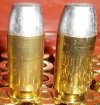joethereloader
New Member
I want to try heavy loads in my 45 Acp I can't make up my mind on which mold maker
More information please.I want to try heavy loads in my 45 Acp I can't make up my mind on which mold maker
sig p220 maybe h k tack with a jarvis barrel 260 to 270 grain cast bulletMore information please.
Heavy bullet?
High pressure/velocity?
both?
What type of gun?
WHY ????????
sig p220 hk tacticalWhat gun will these "heavy loads" be used in?
joethe reloader - I agree with Ian, There's not much to be gained by going with a "heavy for caliber" bullet.sig p220 maybe h k tack with a jarvis barrel 260 to 270 grain cast bullet
So essentially a new gun?462 has a good point about the springs! I routinely ran 28# recoil springs (and replaced them every 1k rounds or so); I think stock is somewhere around 20#.
For a while I ran heavy loads with a frame buffer on the stock recoil spring guide. I had to rebuild the gun due to damage to the locking lugs on the barrel and slide. My rebuild included fitting a new slide, a match barrel and bushing, installing a Dwyer Group Gripper (and a custom-length Dwyer link), fitting a new barrel pin, and installing an extra power firing pin spring. After that there were only a couple factory loads it would run with.
You're in LBT territory with these bullet weights. Veral at Lead Bullet Technologies specializes in cast bullet designs heavy for caliber with as much of the bullet weight as possible in the nose, maximizing case room for powder. This would likely require an LFT (Long Flat Nose) design, and you'll have to work up your own loads for this project. Veral doesn't offer any data whatsoever since much of what he does is custom work to the buyers specifications. According to his website he draws the line at 260 grains for this combination. Expect to answer specific questions about what you're doing, how you're doing it, and about your goals. Once he receives payment he will cut the mould according to the information you give him. Be prepared, he can be a mite cranky at times, but he's one of the best men I've dealt with for custom work. No, he doesn't accept credit cards. https://lbtmolds.com/OurMolds/tabid/5807/Default.aspx#autosig p220 maybe h k tack with a jarvis barrel 260 to 270 grain cast bullet

thank you all for answeringI want to try heavy loads in my 45 Acp I can't make up my mind on which mold maker
